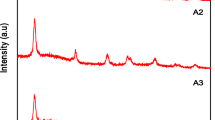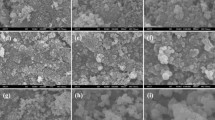Abstract
TiO2/ZnO nanocomposites with ratio of Ti/Zn of 1:0, 1:1, 2:1, 3:1 and 0:1 was synthesized by sol–gel and hydrothermal methods. The performance and the photocatalytic of the nanocomposities mechanism were studied by X-ray diffractometer (XRD), Fourier transformed infrared (FT-IR), Brunauer–Emmett–Teller method (BET), Transmission Electron Microscopy (TEM), High-Resolution Transmission Electron Microscope (HRTEM) and UV–visible diffuse reflectance spectra (UV-Vis), respectively. The results showed that TiO2/ZnO nanocomposites successfully prepared at different Ti/Zn rations. HRTEM results clearly heterojunction structure, and it can reduce the band gap width of the composite and improve the optical absorption intensity. Besides, the degradation rate of methylene blue (MB) of TiO2/ZnO nanocomposites with a Ti/Zn ratio of 2:1 was close to 100% at 80 min, which was better than the other four samples. The photocatalytic degradation reaction confirmed to the first-order kinetic equation. The kinetic constant of TiO2/ZnO nanocomposites with a ratio of 2:1 is 0.03748 min−1, which is 2.8 times of pure ZnO and 4.8 times of pure TiO2, respectively. In addition, the major active species of the photocatalytic reaction are •OH and h+ through activity capture experiments. The improvement of the catalytic performance of TiO2/ZnO nanocomposites is mainly due to the ability to separate holes and electrons.

Highlights
-
High efficiency TiO2/ZnO photocatalysts are prepared by sol–gel and hydrothermal technology.
-
Increase in catalytic efficiency due to the separation efficiency of electrons and holes.
-
MB decolorization is not directly related to adsorption.
-
The degradation of MB is a first order degradation kinetics.
-
The major reactive species for photodegradation is the •OH.











Similar content being viewed by others
References
Dasgupta J, Sikder J, Chakraborty S, Curcio S, Drioli E (2015) Remediation of textile effluents by membrane based treatment techniques: a state of the art review. J Environ Manag 147:55–72. https://doi.org/10.1016/j.jenvman.2014.08.008
Tang XM, Zheng HL, Teng HK, Sun YJ, Guo JS, Xie WY, Yang QQ, Chen W (2016) Chemical coagulation process for the removal of heavy metals from water: a review. Desalination Water Treat 57(4):1733–1748. https://doi.org/10.1080/19443994.2014.977959
Gusain R, Gupta K, Joshi P, Khatri O (2019) Adsorptive removal and photocatalytic degradation of organic pollutants using metal oxides and their composites: a comprehensive review. Adv Colloid Interface Sci 272:102009. https://doi.org/10.1016/j.cis.2019.102009
Hu EL, Shang SM, Tao XM, Jiang SX, Chiu KL (2016) Regeneration and reuse of highly polluting textile dyeing effluents through catalytic ozonation with carbon aerogel catalysts. J Clean Prod 137:1055–1065. https://doi.org/10.1016/j.jclepro.2016.07.194
Nguyen CH, Fu CC, Juang RS (2018) Degradation of methylene blue and methyl orange by palladium-doped TiO2 photocatalysis for water reuse: efficiency and degradation pathways. J Clean Prod 202:413–lp. https://doi.org/10.1016/j.jclepro.2018.08.110
Reddy PAK, Reddy PVL, Kwon E, Kim KH, Akter T, Kalagara S (2016) Recent advances in photocatalytic treatment of pollutants in aqueous media. Environ Int 91:94–103. https://doi.org/10.1016/j.envint.2016.02.012
Yahya N, Aziz F, Jamaludin NA, Mutalib MA, Ismail AF, Salleh WNW, Ludin NA (2018) A review of integrated photocatalyst adsorbents for wastewater treatment. J Environ Chem Eng 6(6):7411–7425. https://doi.org/10.1016/j.jece.2018.06.051
Liu BS, Zhao XJ, Terashima C, Fujishima A, Nakata K (2014) Thermodynamic and kinetic analysis of heterogeneous photocatalysis for semiconductor systems. Phys Chem Chem Phys 16(19):8751–8760. https://doi.org/10.1039/C3CP55317E
Augugliaro V, Litter M, Palmisano L, Soria J (2006) The combination of heterogeneous photocatalysis with chemical and physical operations: a tool for improving the photoprocess performance. J Photochem Photobiol, C 7(4):127–144. https://doi.org/10.1016/j.jphotochemrev.2006.12.001
Herrmann JM (2010) Photocatalysis fundamentals revisited to avoid several misconceptions. Appl Catal B Environ 99:461–468. https://doi.org/10.1016/j.apcatb.2010.05.012
Zhu L, Liu GC, Duan XC, Zhang ZJ (2010) A facile wet chemical route to prepare ZnO/TiO2 nanotube composites and their photocatalytic activities. J Mater Res 25:1278–1287. https://doi.org/10.1557/jmr.2010.0172
Ong CB, Ng LY, Mohammad AW (2018) A review of ZnO nanoparticles as solar photocatalysts: synthesis, mechanisms and applications. Renew Sust Energ Rev 81:536–551. https://doi.org/10.1016/j.rser.2017.08.020
Zhang ML, An TC, Liu XL, Hu XH, Sheng GY, Fu JM (2010) Preparation of a high-activity ZnO/TiO2 photocatalyst via homogeneous hydrolysis method with low temperature crystallization. Mater Lett 64:1883–1886. https://doi.org/10.1016/j.matlet.2010.05.054
Linsebigler AL, Lu GQ, John TY (1995) Photocatalysis on TiO2 surfaces: principles, mechanisms, and selected results. Chem Rev 95:735–758
Daghrir R, Drogui P, Robert D (2013) Modified TiO2 for environmental photocatalytic applications: a review. Ind Eng Chem Res 52:3581–3599. https://doi.org/10.1021/ie303468t
Mukherjee D, Barghi S, Ray AK (2014) Degradation of methyl orange by TiO2/polymeric film photocatalyst. Can J Chem Eng 92(9):1661–1666. https://doi.org/10.1002/cjce.22028
Devi LG, Kavitha R (2013) A review on nonmetal ion doped titania for the photocatalytic degradation of organic pollutants under UV/solar light: role of photogenerated charge carrier dynamics in enhancing the activity. Appl Catal B Environ 140:559–587. https://doi.org/10.1016/j.apcatb.2013.04.035
Akpan UG, Hameed BH (2010) The advancements in sol–gel method of doped-TiO2 photocatalysts. Appl Catal A Gen 375:1–11. https://doi.org/10.1016/j.apcata.2009.12.023
Xiao FX (2012) Self-assembly preparation of gold nanoparticles-TiO2 nanotube arrays binary hybrid nanocomposites for photocatalytic applications. J Mater Chem 22:7819–7830. https://doi.org/10.1039/C2JM16452C
Pelaez M, Nolan NT, Pillai SC, Seery MK, Falaras P, Kontos AG, Dunlop PSM, Hamilton JWJ, Byrne JA, O'Shea K, Entezari MH, Dionysiou DD (2012) A review on the visible light active titanium dioxide photocatalysts for environmental applications. Appl Catal B Environ 125:331–349. https://doi.org/10.1016/j.apcatb.2012.05.036
Pei CC, Leung WWF (2013) Enhanced photocatalytic activity of electrospun TiO2/ZnO nanofibers with optimal anatase/rutile ratio. Catal Commun 37:100–104. https://doi.org/10.1016/j.catcom.2013.03.029
Sun WT, Meng SG, Zhang SJ, Zheng XZ, Ye XJ, Fu XL, Chen SF (2018) Insight into the transfer mechanisms of photogenerated carriers for heterojunction photocatalysts with the analogous positions of valence band and conduction band: a case study of ZnO/TiO2. J Phys Chem C 122(27):15409–15420. https://doi.org/10.1021/acs.jpcc.8b03753
Wu J, Li CE, Chen XT, Zhang J, Zhao LL, Huang TF, Hua T, Zhang C, Ni B, Zhou X, Liang PK, Zhang WB (2017) Photocatalytic oxidation of gas-phase HgO by carbon spheres supported visible-light-driven CuO–TiO2. J Ind Eng Chem 46:416–425. https://doi.org/10.1016/j.jiec.2016.11.012
Chen X, Zhang J, Jiang XD, Wang HB, Kong Z, Xi JH, Ji ZG (2018) Curved surface TiO2 nanodrums coupled with MoS2 as heterojunction photocatalysts with enhancing photocatalytic activity. Mater Lett 229:277–280. https://doi.org/10.1016/j.matlet.2018.07.051
Duan ZF, Zhu Y, Hu ZD, Zhang JY, Liu DJ, Luo X, Gao MH, Lei L, Wang XH, Zhao GY (2020) Micro-patterned NiFe2O4/Fe–TiO2 composite films: fabrication, hydrophilicity and application in visible-light-driven photocatalysis. Ceram Int 46(17):27080–27091. https://doi.org/10.1016/j.ceramint.2020.07.185
Chen D, Zhang H, Hu S, Li JH (2008) Preparation and enhanced photoelectrochemical performance of coupled bicomponent ZnO−TiO2 nanocomposites. J Phys Chem C 112(1):117–122. https://doi.org/10.1021/jp077236a
Barreca D, Comini E, Ferrucci AP, Gasparotto A, Maccato C, Maragno C, Sberveglieri G, Tondello E (2007) First example of ZnO−TiO2 nanocomposites by chemical vapor deposition: structure, morphology, composition, and gas sensing performances. Chem Mater 19(23):5642–5649. https://doi.org/10.1021/cm701990f
Konyar M, Yatmaz HC, Öztürk K (2012) Sintering temperature effect on photocatalytic efficiencies of ZnO/TiO2 composite plates. Appl Surf Sci 258(19):7440–7447. https://doi.org/10.1016/j.apsusc.2012.04.058
Tian JT, Chen LJ, Yin YS, Wang X, Dai JH, Zhu ZB, Liu XY, Wu PW (2009) Photocatalyst of TiO2/ZnO nano composite film: preparation, characterization, and photodegradation activity of methyl orange. Surf Coat Technol 204(1-2):205–214. https://doi.org/10.1016/j.surfcoat.2009.07.008
Wang J, Wang GH, Wei XH, Liu G, Li J (2018) ZnO nanoparticles implanted in TiO2 macrochannels as an effective direct Z-scheme heterojunction photocatalyst for degradation of RhB. Appl Surf Sci 456:666–675. https://doi.org/10.1016/j.apsusc.2018.06.182
Siwińska-Stefańska K, Kubiak A, Piasecki A, Dobrowolska A, Czaczyk K, Motylenko M, Rafaja D, Ehrlich H, Jesionowski T (2019) Hydrothermal synthesis of multifunctional TiO2-ZnO oxide systems with desired antibacterial and photocatalytic properties. Appl Surf Sci 463:791–801. https://doi.org/10.1016/j.apsusc.2018.08.256
Mukhopadhyay S, Maiti D, Chatterjee S, Devi PS, Kumar GS (2018) Design and application of Au decorated ZnO/TiO2 as a stable photocatalyst for wide spectral coverage. Phys Chem Chem Phys 18(46):31622–31633. https://doi.org/10.1039/C6CP06903G
Wang YZ, Zhu SP, Chen XR, Tang YG, Jiang YF, Peng ZG, Wang HY (2014) One-step template-free fabrication of mesoporous ZnO/TiO2 hollow microspheres with enhanced photocatalytic activity. Appl Surf Sci 307:263–271. https://doi.org/10.1016/j.apsusc.2014.04.023
Upadhyay GK, Pathak JK, Pathak TK, KumaracL V, Purohita P(2019) Synthesis of ZnO:TiO2 nanocomposites for photocatalyst application in visible light Vaccuum 160:154–163. https://doi.org/10.1016/j.vacuum.2018.11.026
Li SS, Huang L, Zhang HJ, Huang Z, Jia QL, Zhang SW (2020) Adsorption mechanism of methylene blue on oxygen-containing functional groups modified graphitic carbon spheres: experiment and DFT study, Apl Surf Sci https://doi.org/10.1016/j.apsusc.2020.148386
Chang CJ, Lin CY, Chen JK, Hsu MH (2014) Ce-doped ZnO nanorods based low operation temperature NO2 gas sensors. Ceram Int 40:10867–10875. https://doi.org/10.1016/j.ceramint.2014.03.080
Asiltürk M, Şener Ş (2012) TiO2-activated carbon photocatalysts: preparation, characterization and photocatalytic activities. Chem Eng J 180:354–363. https://doi.org/10.1016/j.cej.2011.11.045
Lin H, Huang CP, Li W, Ni C, Shah SI, Tsen YH (2006) Size dependency of nanocrystalline TiO2 on its optical property and photocatalytic reactivity exemplified by 2-chlorophenol. Appl Catal B Environ 68:1–11
Yadav V, Sainia VK, Sharma H (2020) How different dopants leads to difference in photocatalytic activity in doped TiO2? Ceram Int 46(17):27308–27317. https://doi.org/10.1016/j.ceramint.2020.07.216
Choudhary S, Bisht A, Mohapatra S (2020) Microwave-assisted synthesis of α-Fe2O3/ZnFe2O4/ZnO ternary hybrid nanostructures for photocatalytic applications, Ceram Int https://doi.org/10.1016/j.ceramint.2020.09.243
Selvaraj S, Mohan MK, Navaneethan M, Ponnusamy S, Muthamizhchelvan C (2019) Synthesis and photocatalytic activity of Gd doped ZnO nanoparticles for enhanced degradation of methylene blue under visible light. Mater Sci Semicond Process 103:104622. https://doi.org/10.1016/j.mssp.2019.104622
Acknowledgements
This work was supported by the National Natural Science Foundation of China [grant number 51602252]; the National Key Basic Research and Development Project Subproject [grant number 2017YFC0703204].
Author information
Authors and Affiliations
Corresponding author
Ethics declarations
Conflict of interest
The authors declare no competing interests.
Additional information
Publisher’s note Springer Nature remains neutral with regard to jurisdictional claims in published maps and institutional affiliations.
Rights and permissions
About this article
Cite this article
Bai, N., Liu, X., Li, Z. et al. High-efficiency TiO2/ZnO nanocomposites photocatalysts by sol–gel and hydrothermal methods. J Sol-Gel Sci Technol 99, 92–100 (2021). https://doi.org/10.1007/s10971-021-05552-8
Received:
Accepted:
Published:
Issue Date:
DOI: https://doi.org/10.1007/s10971-021-05552-8




